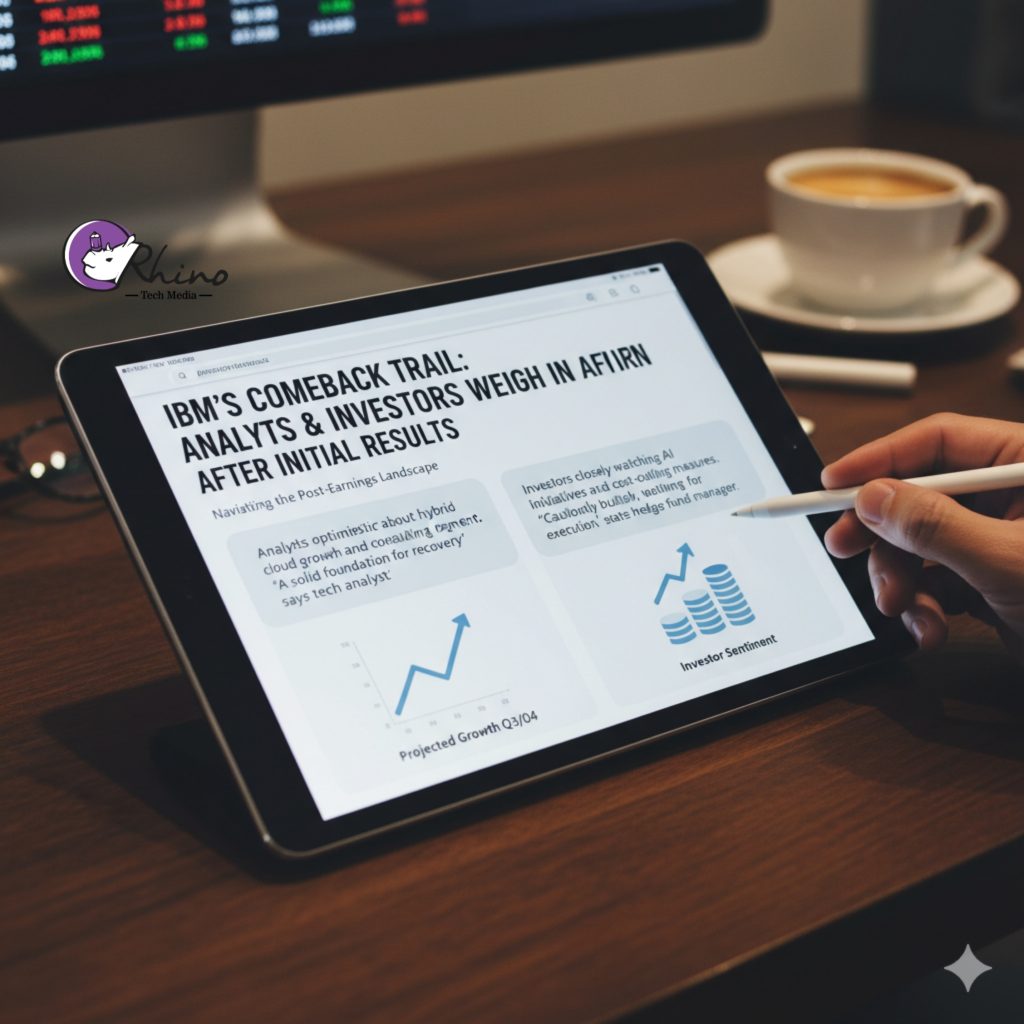IBM posted a mixed but strategically important quarter: it beat headline EPS and revenue estimates, and management nudged full-year guidance higher — yet the market’s initial reaction was negative because the company showed signs of slowing momentum in the parts of the business investors prize most. Analysts and investors are parsing those mixed signals, and their views fall into a few clear themes: guarded optimism about AI/mainframe strength, concern about Red Hat/hybrid-cloud deceleration, questions about valuation versus peers, and close scrutiny of execution on margin and cash-flow goals.
1. The headline: beats + raised outlook, but a sour market reaction
On the surface IBM delivered: revenue and EPS topped expectations and management modestly raised full-year revenue guidance (to “more than 5%” constant-currency growth). That beat was led by strength in infrastructure — notably AI-enabled mainframes — and better than expected overall revenue. Nevertheless, investors punished the stock after the quarter because growth in IBM’s high-margin, strategically critical hybrid-cloud software business (the Red Hat-anchored unit) decelerated — an outcome the market interprets as a threat to sustainable, premium growth rates. The shares fell meaningfully in after-hours and the following sessions despite the beats.
2. Analysts: cautious praise, with the spotlight on Red Hat and margins
Analysts broadly acknowledged the operational positives — the AI/mainframe strength, improved guidance and solid free-cash-flow targets — but many emphasized that IBM’s multiple relies on continued above-market growth from software/cloud. Firms such as J.P. Morgan and other sell- and buy-side commentators flagged the Red Hat slowdown (growth slipping from prior quarters) as the main risk to the narrative that IBM can compound value from AI + hybrid cloud. Several analysts reiterated that while near-term fundamentals look fine, the company must show a credible path back to faster software growth to justify its premium valuation versus rivals. Model updates and target-price tinkering followed: some houses trimmed near-term upside, others kept ratings but warned investors the story now requires clearer proof of durable cloud momentum.
3. Investors: a mix of profit-taking, valuation worries, and selective conviction
Investor reaction has three shades. First, short-term traders and some institutional accounts used the deceleration signal as a reason to sell, producing sharp intraday moves despite the beat. Second, long-term value and income investors are watching management’s cash-flow and cost-savings metrics (IBM has been touting productivity gains and large cost-reduction targets) and some remain constructive if free cash flow and buybacks continue. Third, a subset of growth-oriented investors is more skeptical: they want to see Red Hat return to mid-teens growth (management has suggested that is attainable by 2026) and for acquisitions and product rollouts (e.g., HashiCorp integration, AI tooling) to start showing revenue leverage. Overall, the market’s move suggests investors now demand clearer evidence that IBM’s AI tailwinds translate into sustained software expansion.
4. The management defense and credibility bank
Management levers its credibility around three commitments: (1) restoring faster growth in Red Hat/hybrid cloud, (2) demonstrating AI product monetization beyond mainframe hardware, and (3) delivering on free-cash-flow and margin improvement goals. Executives emphasized AI adoption and infrastructure strength as proof the strategy is working, and they reiterated targets for cash generation and cost savings. Analysts note that commitments are necessary but not sufficient — execution on product roadmap, channel momentum, and enterprise spending patterns (especially government and consulting demand) will determine whether the stock’s premium is justified.
5. Valuation and the “what-if” scenarios analysts are using
Because IBM has traded at a relatively high forward P/E compared with some peers, several analysts now model two central scenarios: a base case where AI/mainframe strength offsets slower Red Hat growth (result: modest upside if cash flows hold), and a downside case where hybrid-cloud growth remains sluggish and multiples compress (result: significant downside even if EPS holds). That split explains why headlines that would normally be unambiguously positive (an earnings beat + a raise) still triggered a selloff — investors are re-pricing the probability of the more optimistic scenario.
6. Market takeaway and what to watch next
In short, the quarter likely represents a tactical rebound in some product lines (AI/mainframe, infrastructure) but a strategic challenge remains for IBM: turn AI interest into durable cloud/software growth at scale. Key watch-items for analysts and investors over the coming quarters: (a) sequential growth at Red Hat/hybrid cloud, (b) revenue contribution and margins from AI software products (beyond hardware sales), (c) progress integrating acquisitions (e.g., HashiCorp) to expand cloud tooling revenue, and (d) continued evidence that the company’s cost-savings and free-cash-flow targets materialize. Positive readings on these fronts would validate management’s rebound narrative; continued deceleration in the software engine would keep the stock under pressure.
Conclusion
Analysts and investors are sending a clear message: IBM can — and in parts already does — rebound, but the market will only reward that rebound if it’s broad-based and persistent. The quarter offered encouraging proof points (AI/mainframe strength, a minor guidance lift) but also renewed scrutiny on the high-margin software engine that must sustain the premium multiple. For now, the consensus among commentators is guarded optimism balanced by skepticism — IBM’s next few quarters must show stronger cloud/software traction to convert cautious believers into confident buyers.

